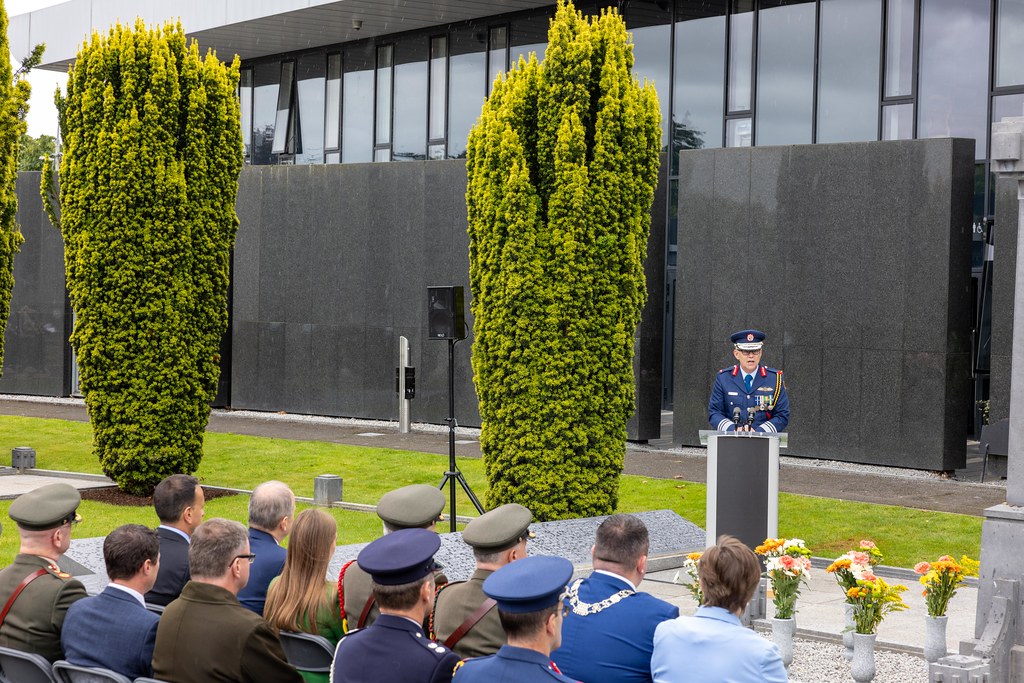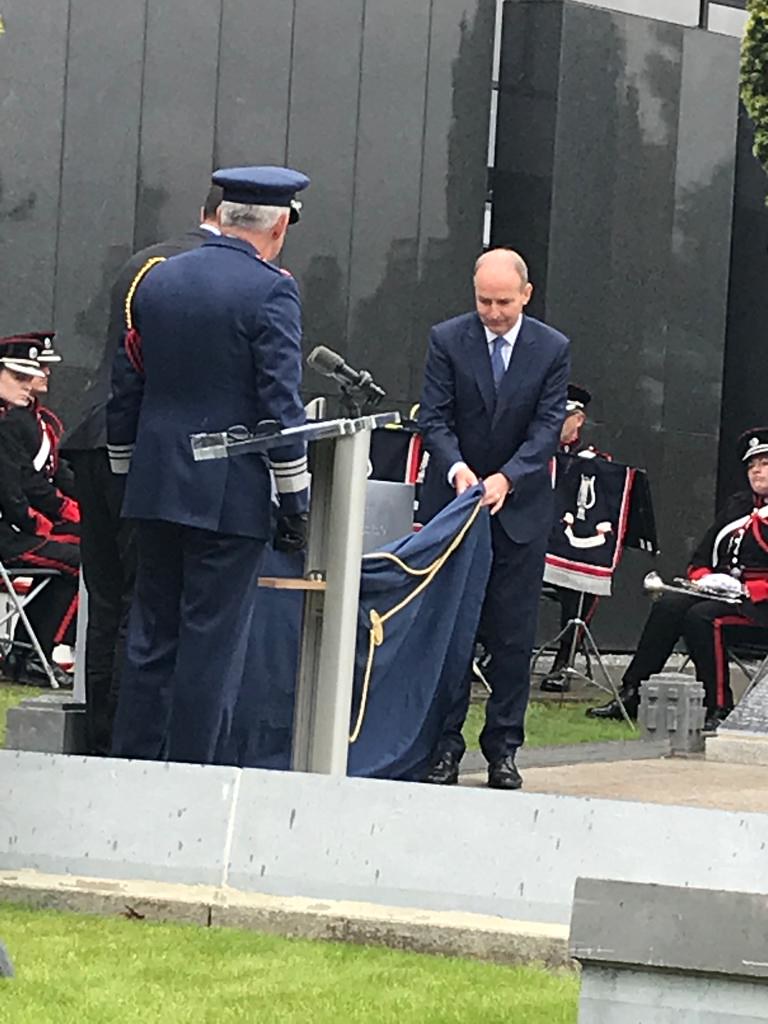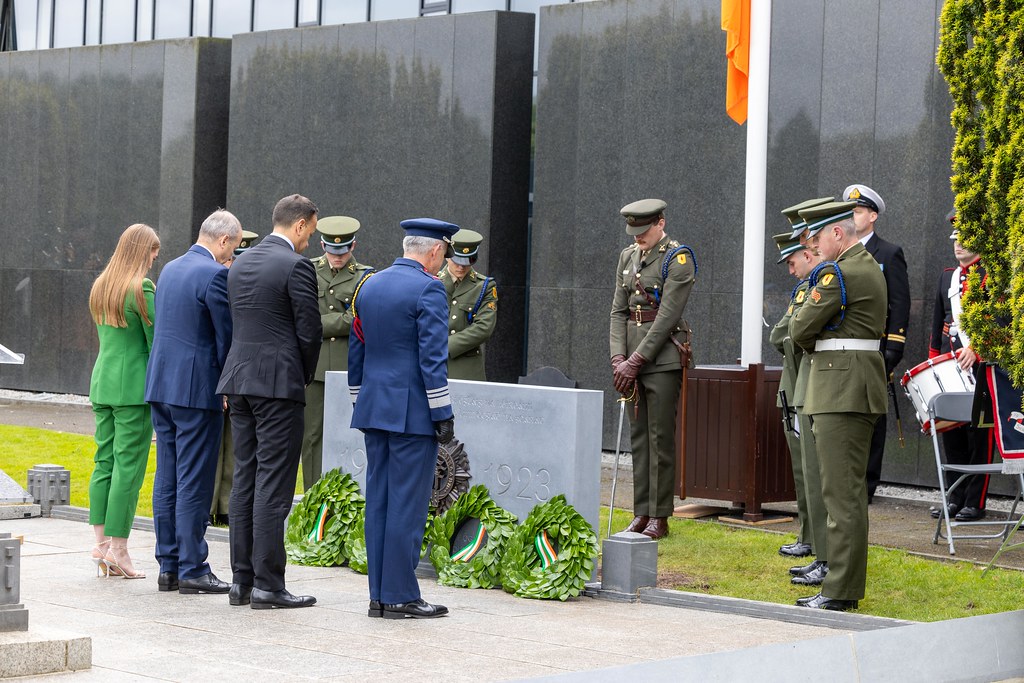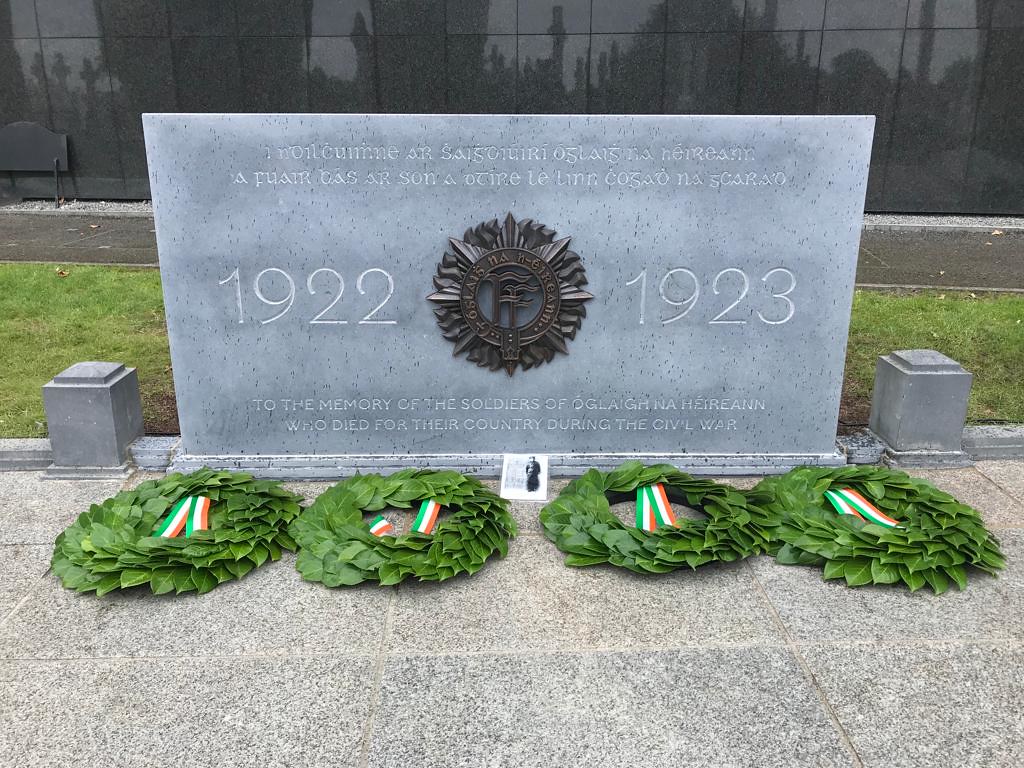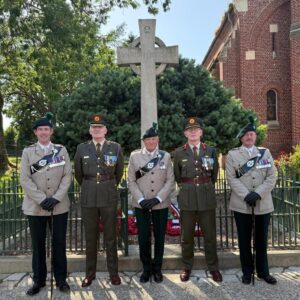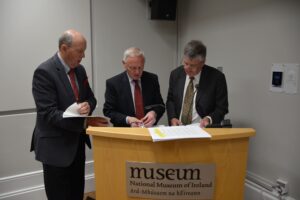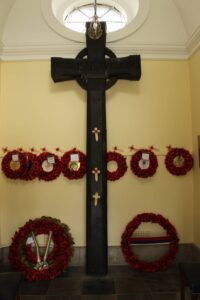On Sunday 30 July, representatives of The Military Heritage of Ireland Trust CLG where honoured to attend the Rededication of the National Army Monument in Glasnevin Cemetery, honouring personnel of the National Army who died during the Civil War, June 1922 – April 1923.
An Taoiseach, Mr Leo Varadkar T.D., the Tánaiste and Minister for Defence, Mr Micheál Martin T.D., and the Chief of Staff of the Defence Forces Lieutenant-General Seán Clancy, participated in the rededication ceremony.
The rededication ceremony, took place on the Sunday nearest to the centenary of the enactment of the Defence Forces (Temporary Provisions) Act 1923, which provides the legal basis for Óglaigh na hÉireann.
Descendants of soldiers of the National Army who died during the Civil War, including a representative family from each of the four provinces on the island of Ireland, were invited guests at the ceremony. Among the invited guests were descendants of General Michael Collins, who was Commander-in-Chief of the National Army from July 1922, until he was killed in action during an ambush on 22 August 1922, at Beál na Bláth, County Cork.
Alongside the UN Plot in Glasnevin Cemetery, the National Army Plot contains the remains of 183 of the estimated 810 National Army soldiers who died in service to the State during the Civil War. The remains of the others lie in graveyards across Ireland. Prior to July 2023, no exclusively dedicated national monument existed to their memory.
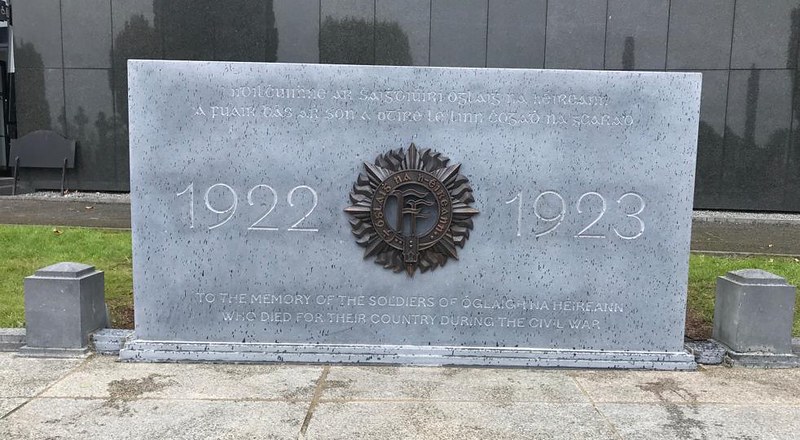
Designed by Mr Gary Blakely, the National Monument, made from Kilkenny blue limestone, takes inspiration from the National Flag, following its proportions and tricolour division.
The focal point of the National Monument is the Defence Forces Badge derived from the badge of the Irish Volunteers, designed by Professor Eoin MacNeill, Chairman of the National Executive of the Irish Volunteers, and adopted by the Irish Volunteers in October 1914 as the official badge of the organisation. The centrepiece is formed of the letters ‘FF’, signifying ‘Fianna Fáil’, the Fianna is the name of the ancient military organisation (circa 3rd Century A.D.), and Fáil means Destiny. The two letters are surrounded by a representation of an ancient warrior’s sword belt, and a circle of flames which represent the ‘Sunburst’ – the traditional battle symbol of the Fianna. The words ‘Óglaigh na h-Éireann’ inscribed around the sword belt mean ‘Soldiers of Ireland’. No particular significance is attached to the representation of the Star which was included to balance the design. The emblem on the National Memorial is darkened in mourning, a tradition dating back to the funeral of General Michael Collins.
The National Monument’s main inscription is in Duibhlinn, the font used to draft the 1937 Irish Constitution. The English text has been rendered in Gaillimh, a font designed for the Galway City of Culture programme in 2020. Ms Aileen-Anne Brannigan carved the Irish text and numerals, Mr Ciarán Byrne carved the English text. The blacksmith sculptor was Mr Michael Calnan, and the bronze casting was done by Athy Co-Op Foundry. The quotation on the reverse of the Monument is from The Municipal Gallery Revisited by William Butler Yeats.
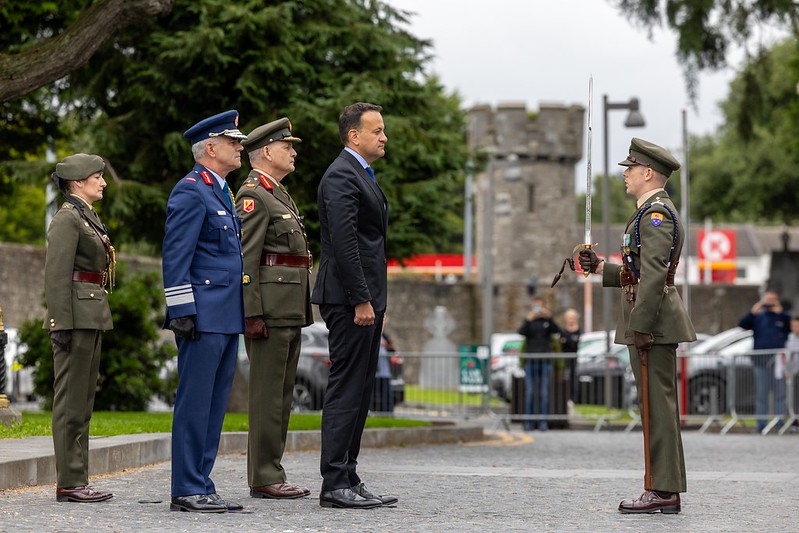
On arrival at Glasnevin, An Taoiseach Mr Leo Varadkar T.D, inspected a Lieutenant’s Guard of Honour drawn from the 1 Infantry Battalion, Dún Úi Mhaoilíosa, Galway.
The Master of Ceremonies was Captain Paul Farrell stationed in Defence Forces Headquarters.
In welcoming the Guests, Lieutenant-General Seán Clancy inter alia said:
“It is appropriate, in the spirit of real inclusiveness, of ethical remembering, and with a full desire to deal with some of the more uncomfortable aspects of our shared history, that we remember some of 810 uniformed members of Óglaigh na hÉireann who gave their lives in the service of the State during the tragic and critical period at the foundation of our democracy.
For far too long there has been no memorial of any kind, nor any complete listing of the National Army war dead. Indeed, this year represents perhaps the last real opportunity to rectify that. Whatever the often very legitimate reasons our forebears may have had for forgetting in the intervening 100 years, I think it is appropriate now that I as the 32nd Chief of Staff of Óglaigh na hÉireann should finally take this opportunity to rehabilitate their memory.”
During the ceremony, musical interludes were provided by a quintet from the Defence Forces School of Music. An extract from The Cure at Troy by Seamus Heany was read by Private Caitlín Beatty.
An Taoiseach, Mr Leo Varadkar T.D., the Tánaiste and Minister for Defence, Mr Micheál Martin T.D., and the Chief of Staff Lieutenant-General Seán Clancy unveiled the National Monument.
Thereafter, Captain Cian Clancy, Defence Forces Headquarters sang Óró Sé do Bheatha Bhaila by Pádraig Mac Piarais. A Prayer of Reflection was offered by Fr Bernard McKay-Morrissey CF.
Wreaths were laid at the National Memorial by Mr Leo Varadkar T.D., Mr Micheál Martin T.D., Lieutenant-General Seán Clancy and Ms Ellen Warde who is a Great Great Great Grand Niece of Private Christopher Kearns who killed in action during an ambush in October 1922 in Ferrycarrig, County Wexford.
The Honour Guard was provided by the 7 Infantry Battalion, the Piper’s Lament titled The Limerick Lament was played by Sergeant Joe Meade, and the Last Post and Reveille were rendered by instrumentalists from the Defence Forces School of Music. The ceremony concluded with the playing of the National Anthem, Amhrán na bhFiann.
In addition to the presiding dignitaries and descendants, attendance included the Lord Mayor of Dublin Councillor Daithí de Roiste, Former Chief’s of Staff: Lieutenant-General Seán McCann DSM and Vice-Admiral Mark Mellett DSM, Secretary-General of the Department of Defence Ms Jacqui McCrum, Dr Maurice Manning Chair Expert Advisory Group Decade of Centenaries, Dr Michael Kennedy Royal Irish Academy, members of the General Staff, GOC 2 Eastern Brigade, GOC Air Corps, FOC Naval Service, representatives of RACO, PDFORRA, ARCO, ONE and IUNVA.
The Military Heritage of Ireland Trust CLG was represented by its Chair, Brigadier-General Paul Fry (Retd), and one if its Directors, Commandant Lar Joye (AR). Another Director, Brigadier-General Paul Pakenham (Retd) representing ARCO was also in attendance.
Following the ceremony, a reception was held in the Exhibition Room, during which Military Archives unveiled its digital interactive nominal roll of National Army personnel who died during the Civil War. The nominal roll provides details of each individual soldier, researched and compiled by military archivists over the last two years led by Lieutenant-Colonel Stephen MacEoin, who following the Rededication Ceremony is quoted as saying:
“We have finally given them their rightful place. Because really, the State, as a modern democracy, would not have come into being if not for the contribution of these soldiers.”
The archival records record those personnel of the National Army who died during the Civil War, were all men, mainly working class and in their early 20s, and mostly unmarried. Apparently, some of them had combat experience from the War of Independence, the Easter Rising, and in some cases with the British Army in the First World War. The nominal roll is currently on loan to the Glasnevin Trust, and will shortly be uploaded in the Military Archives website at: https://www.militaryarchives.ie/home.
Photographs courtesy of Brigadier-General Paul Fry (Retd) and Airman Gibney, Defence Forces Public Relations Section.
Images courtesy of Airman Gibney, PR Branch, DFHQ and Brigadier-General Paul Fry (Retd).

